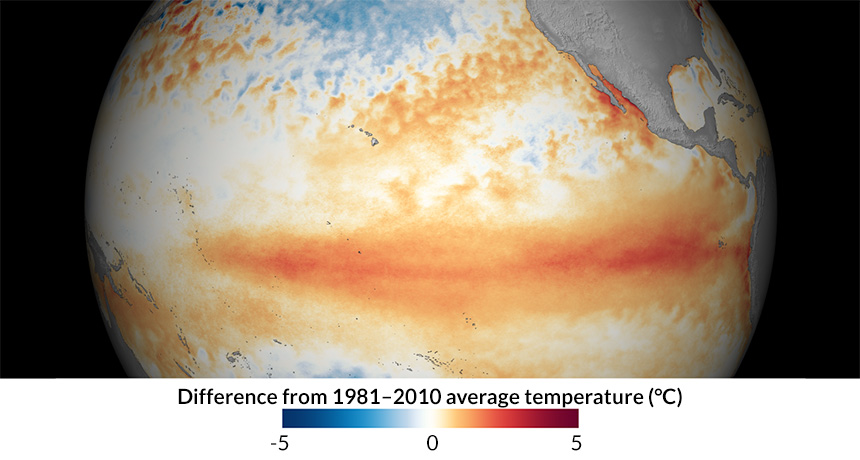Fizzled 2014 El Niño fired up ongoing monster El Niño

The historic El Niño event currently shaking up Earth’s weather rose like a phoenix from the hot remains of a failed 2014 El Niño, new research suggests.
In 2014, the scientific community buzzed about the possibility of a supersized El Niño as warm Pacific Ocean water sloshed eastward. That July, however, large winds pushed westward and halted the budding El Niño before it fully formed (SN: 11/1/14, p. 6). Those same winds also prevented the release of stored-up ocean heat, researchers report in a paper to be published in Geophysical Research Letters. In March 2015, that lingering heat gave the current El Niño a jump start toward the extreme, the researchers propose.
The ongoing El Niño is among the three strongest on record (SN Online: 7/16/15); it has boosted rainfall in California, contributed to ocean coral bleaching and helped make 2015 the hottest year on record (SN: 2/20/16, p. 13). Such a once-in-a-generation El Niño would have been less likely without the failed 2014 event, says study coauthor Michael McPhaden, a physical oceanographer at the National Oceanic and Atmospheric Administration’s Pacific Marine Environmental Laboratory in Seattle.
“In a sense, we dodged a bullet in 2014 by not having a monster El Niño,” McPhaden says. “But that was short-lived, because the conditions that shut that developing El Niño down set up the big one in 2015.”
El Niños typically form every two to seven years when Pacific winds shift a large, near-surface pool of warm water eastward. That warm water then rises to the surface and releases its heat into the atmosphere, causing global shifts in storms, precipitation and temperatures.
The fizzled 2014 El Niño followed by a colossal event in 2015 is very unusual, McPhaden says. He and climate scientist Aaron Levine, also at NOAA’s Pacific Marine Environmental Laboratory, wondered if the sequence of events was just a coincidence. So the researchers looked at decades of El Niño climate data and ran computer simulations of various hypothetical El Niño events.
Under typical ocean conditions, the chances of a 2015 El Niño of any strength are about 27 percent, the researchers estimate. The remnant heat from the failed 2014 El Niño increased those odds to roughly 40 percent. Having a failed El Niño the previous year stacks the deck in favor of an El Niño, McPhaden and Levin conclude. But it “isn’t a guarantee,” Levine says.
A similar aborted El Niño occurred in 1990, the researchers find. An El Niño formed the following year, but the event ended up being more modest than the current super El Niño. That’s in part because the eastward-blowing winds in 1991 were relatively weak, Levine says. Strong El Niños require strong winds, not just warm water, he adds.
Forecasting those winds is tricky because the winds and the warm water “are all part of the same system,” says Kevin Trenberth, a climate scientist at the National Center for Atmospheric Research in Boulder, Colo. Ocean heat can cause atmospheric changes that can in turn influence the winds. The new work provides insights, he says, “but it is far from complete.”